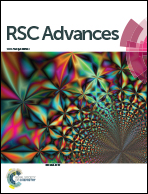Kinetic and deuterium isotope analyses of ammonia electrochemical synthesis†
Abstract
The mechanism of electrochemical promotion of ammonia formation was investigated by kinetic and deuterium isotope analyses using a cell with a Pt (anode)|BaCe0.9Y0.1O3 (BCY)|Fe (cathode) configuration on the introduction of a gaseous mixture of H2(D2)–N2 to the cathode at 550 °C. To clarify the mechanism of electrochemical ammonia synthesis, the reaction orders for hydrogen, α, and nitrogen, β, were investigated. The values of α and β did not change after applying a negative voltage, which indicates that the reaction mechanism at rest potential is the same as that with cathodic polarization. Furthermore, deuterium isotope analysis was conducted to investigate the mechanism of electrochemical promotion. The isotopic composition of ammonia (i.e., NH3−xDx) formed in the cathode was determined using Fourier-transform infrared spectroscopy (FTIR). The results show that the ammonia products with cathodic polarization correspond to the species of H2 (or D2) in the cathode, that is, NH3 (or ND3) was mainly formed when H2 (or D2) was introduced to the cathode. Isotopic analysis revealed that the ammonia formation rate via the electrochemical promotion of catalysis (EPOC) is faster than that via the charge-transfer reaction, suggesting that a significant increase in the ammonia formation rate will be caused by the EPOC.



 Please wait while we load your content...
Please wait while we load your content...